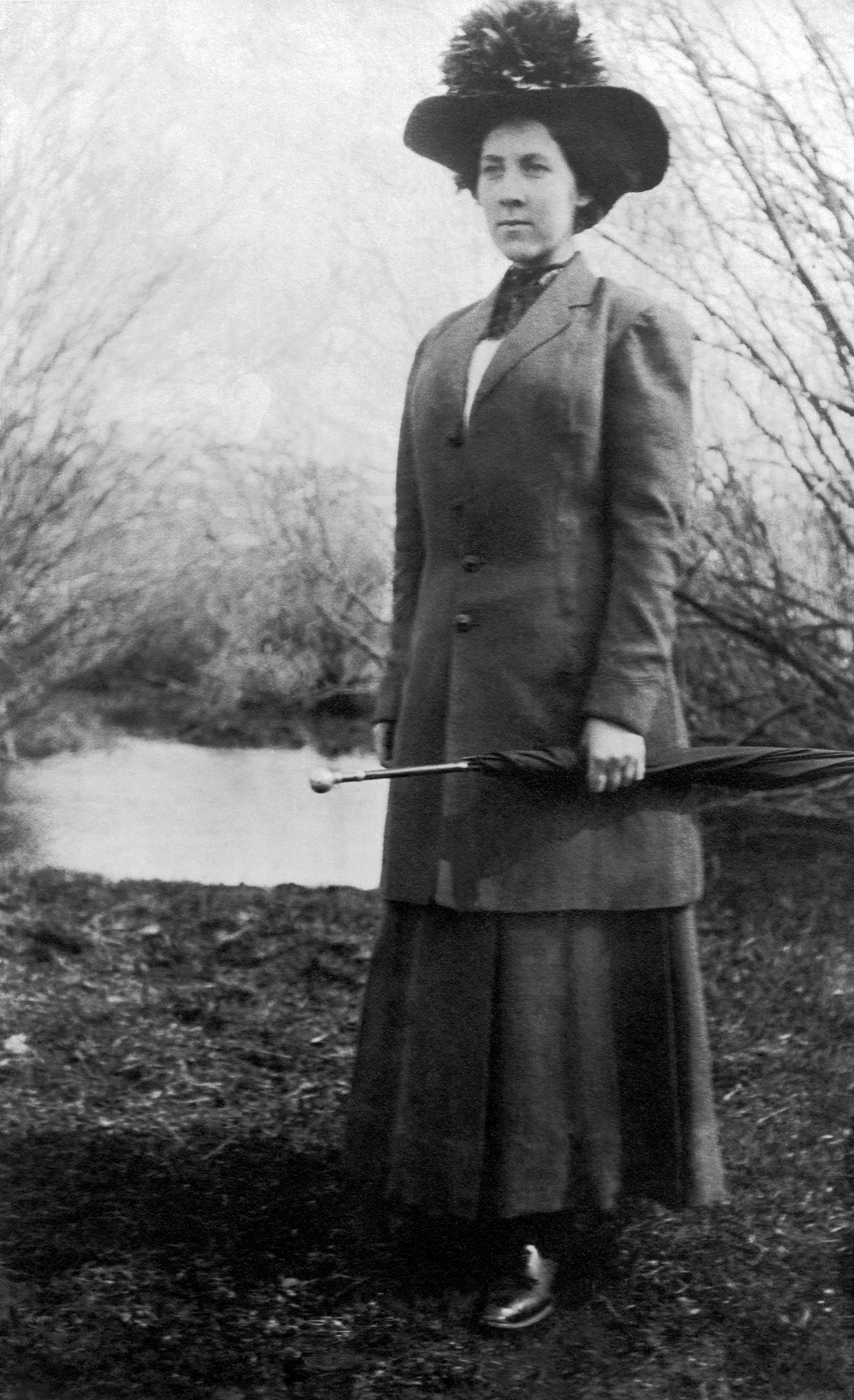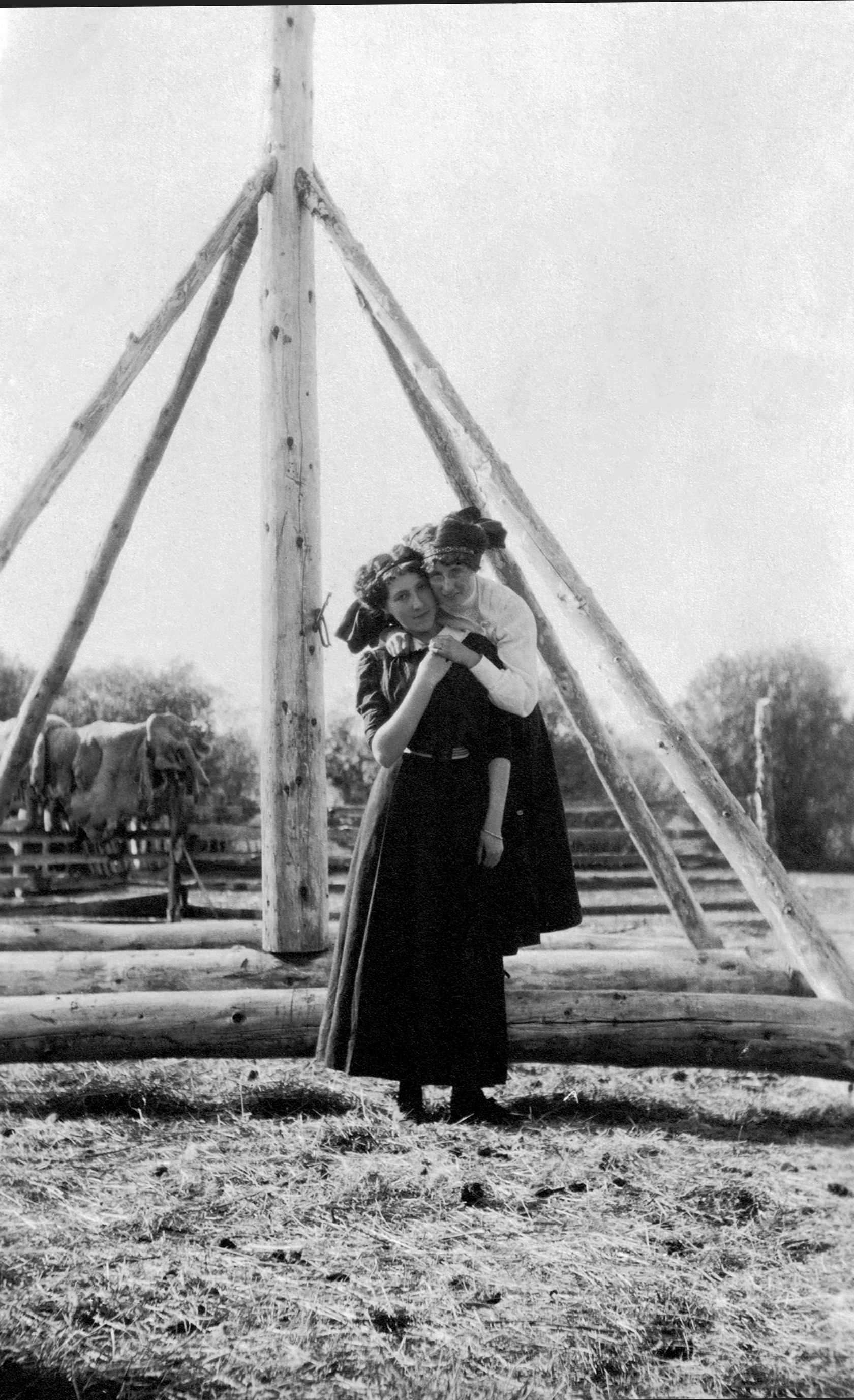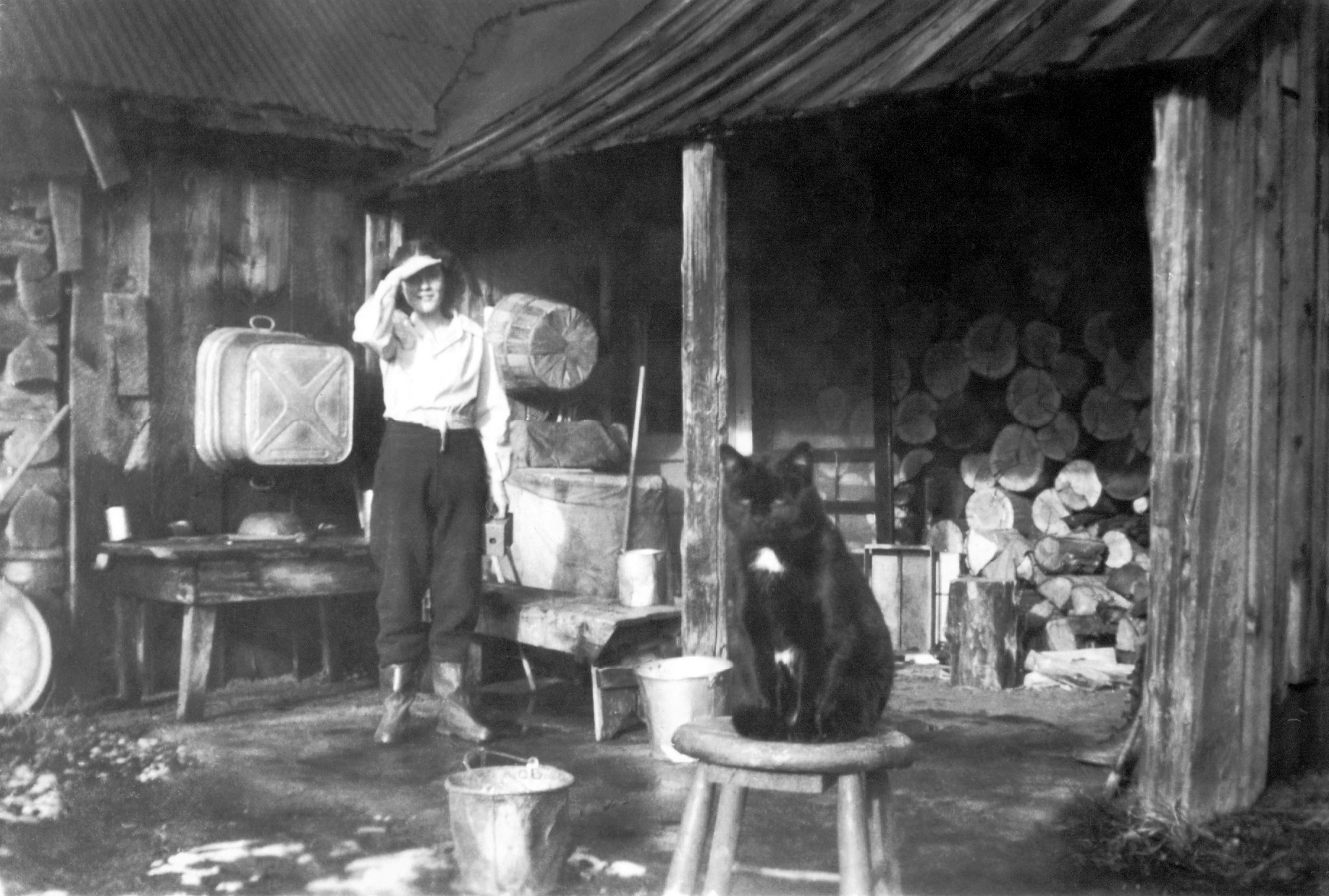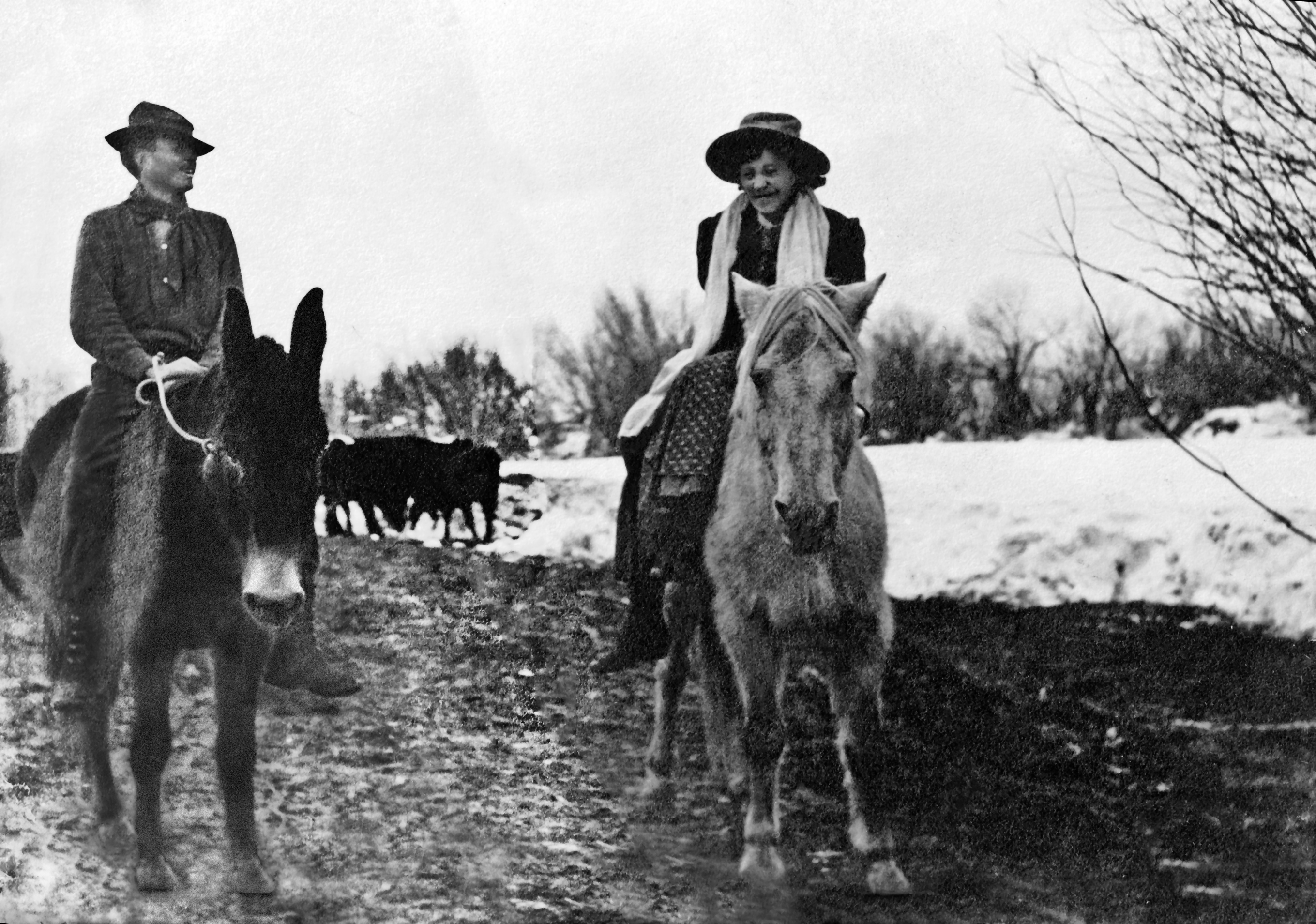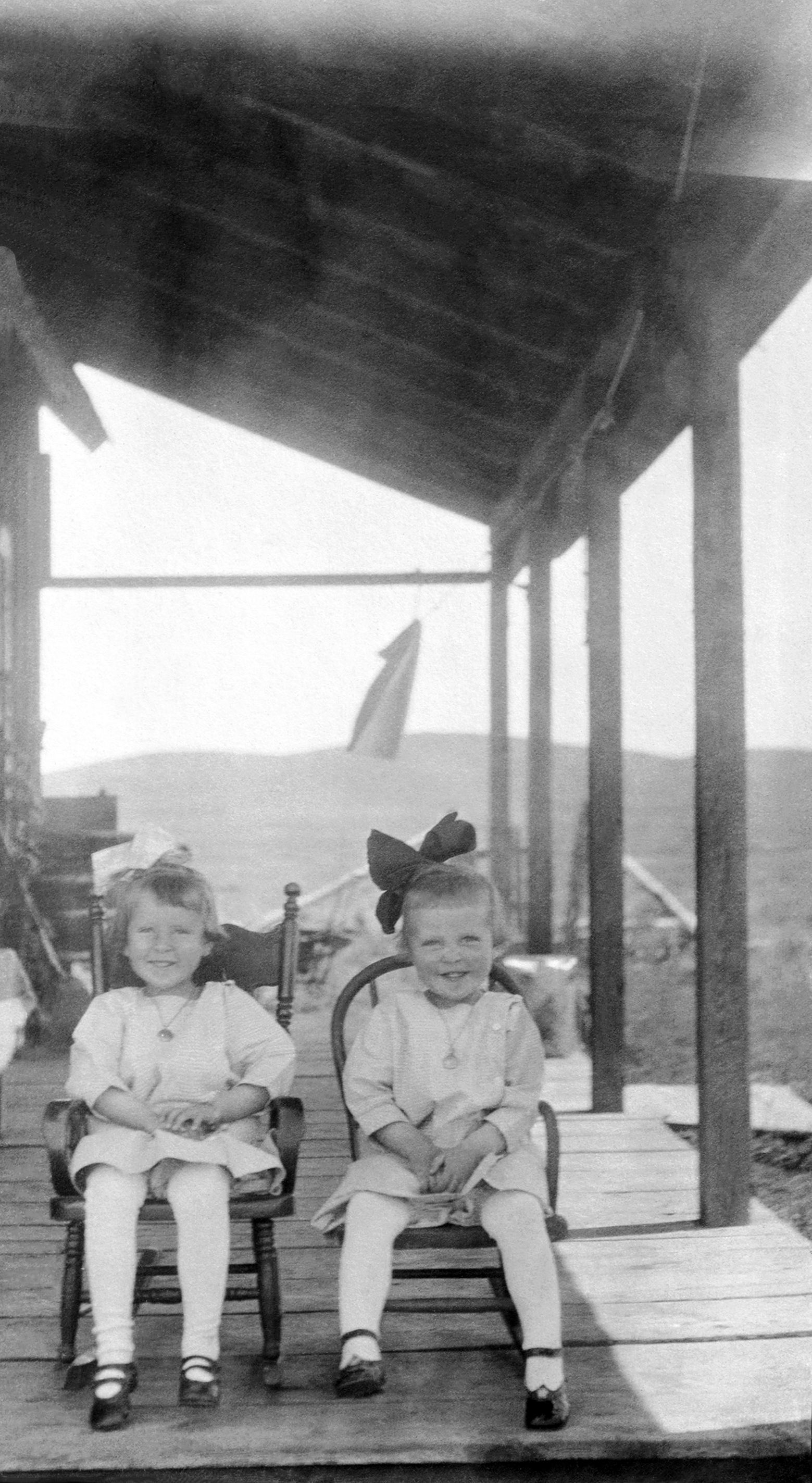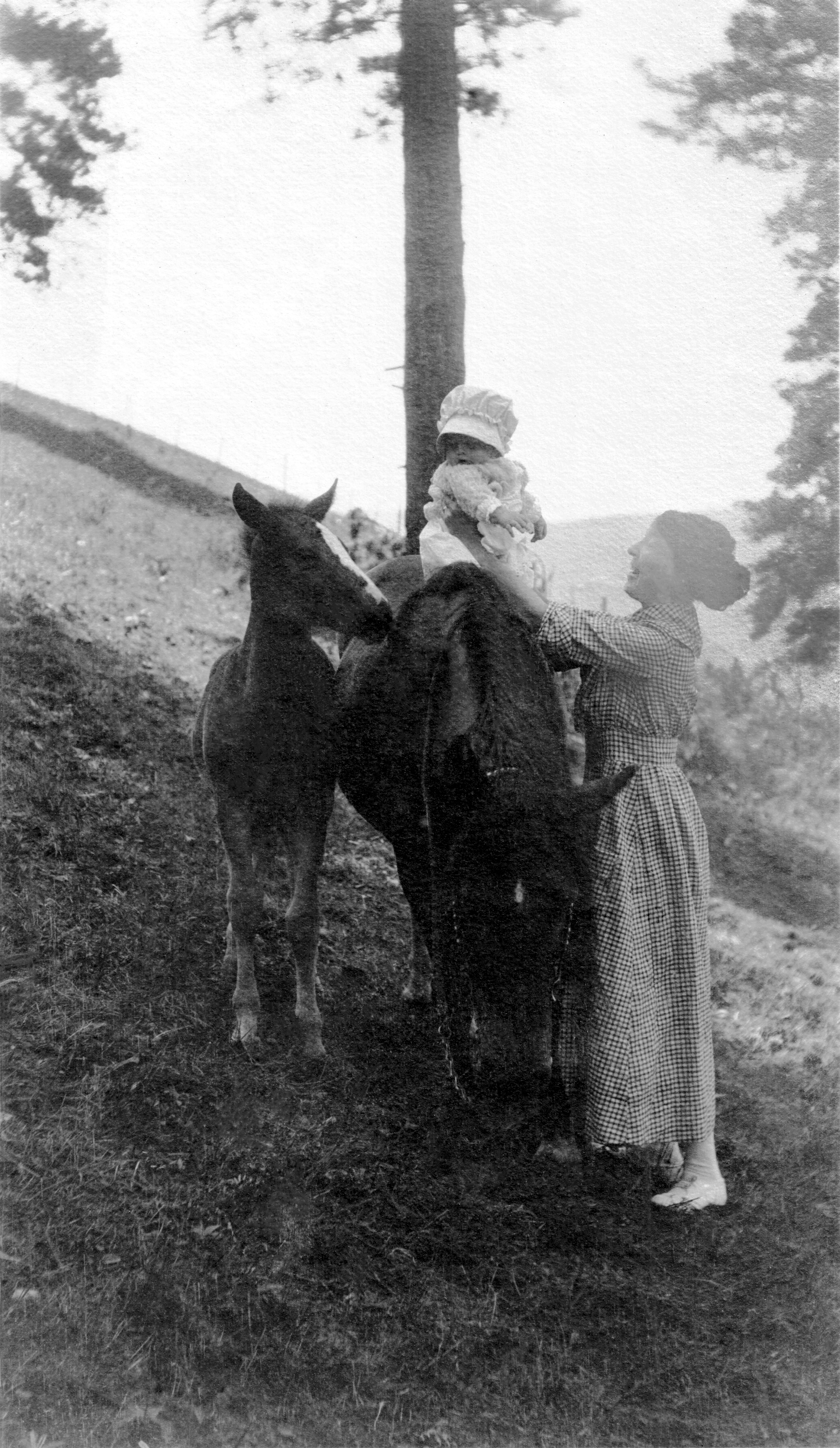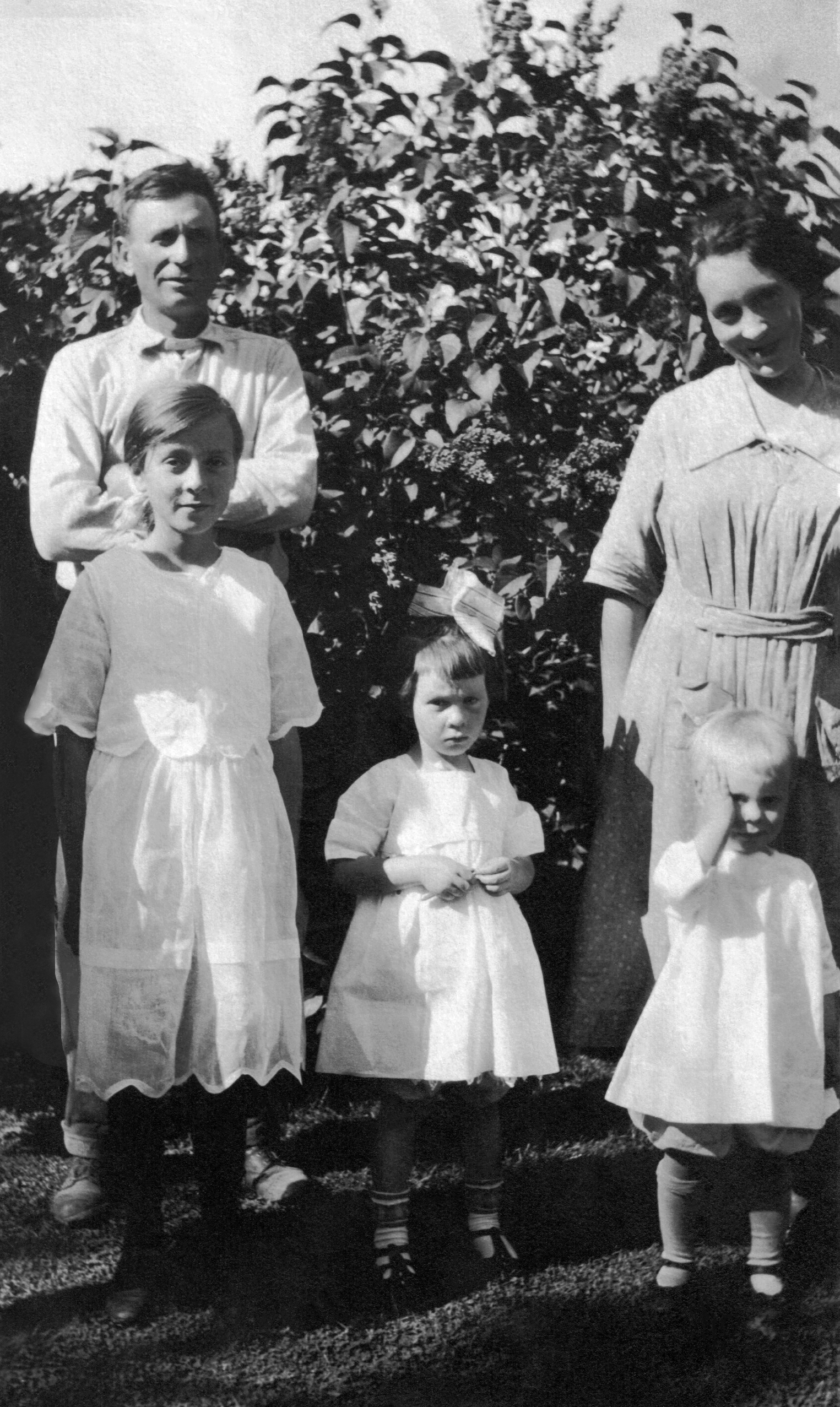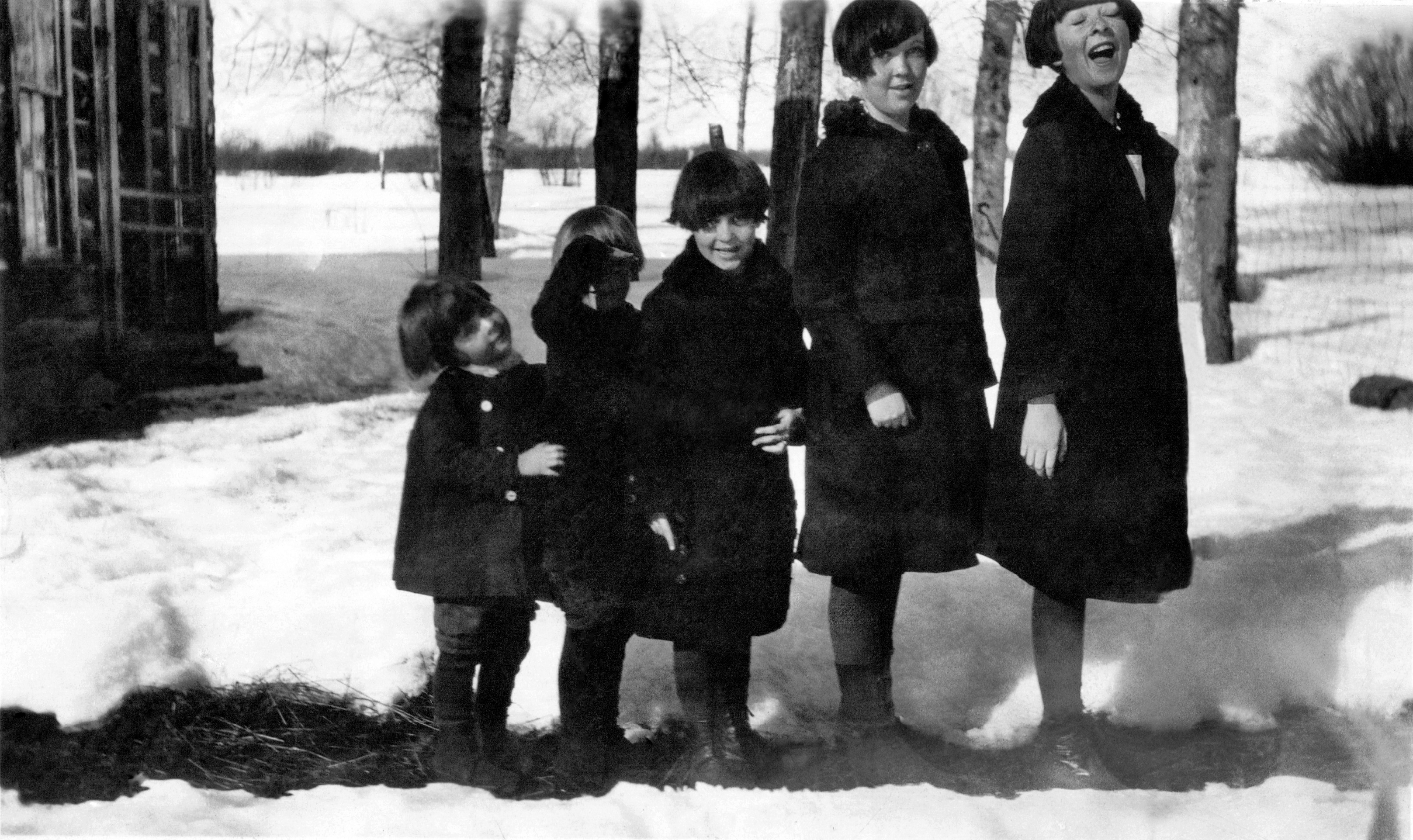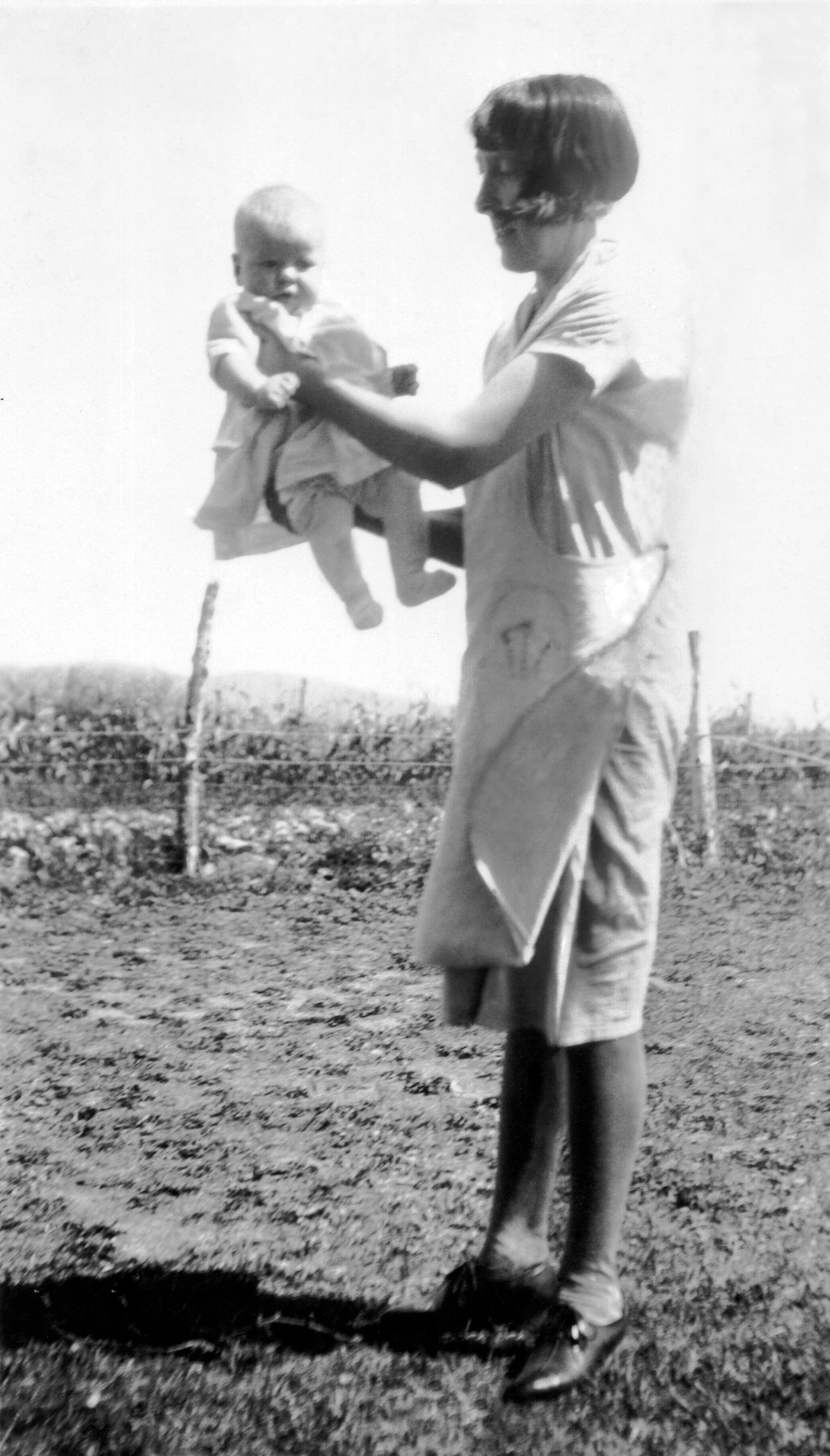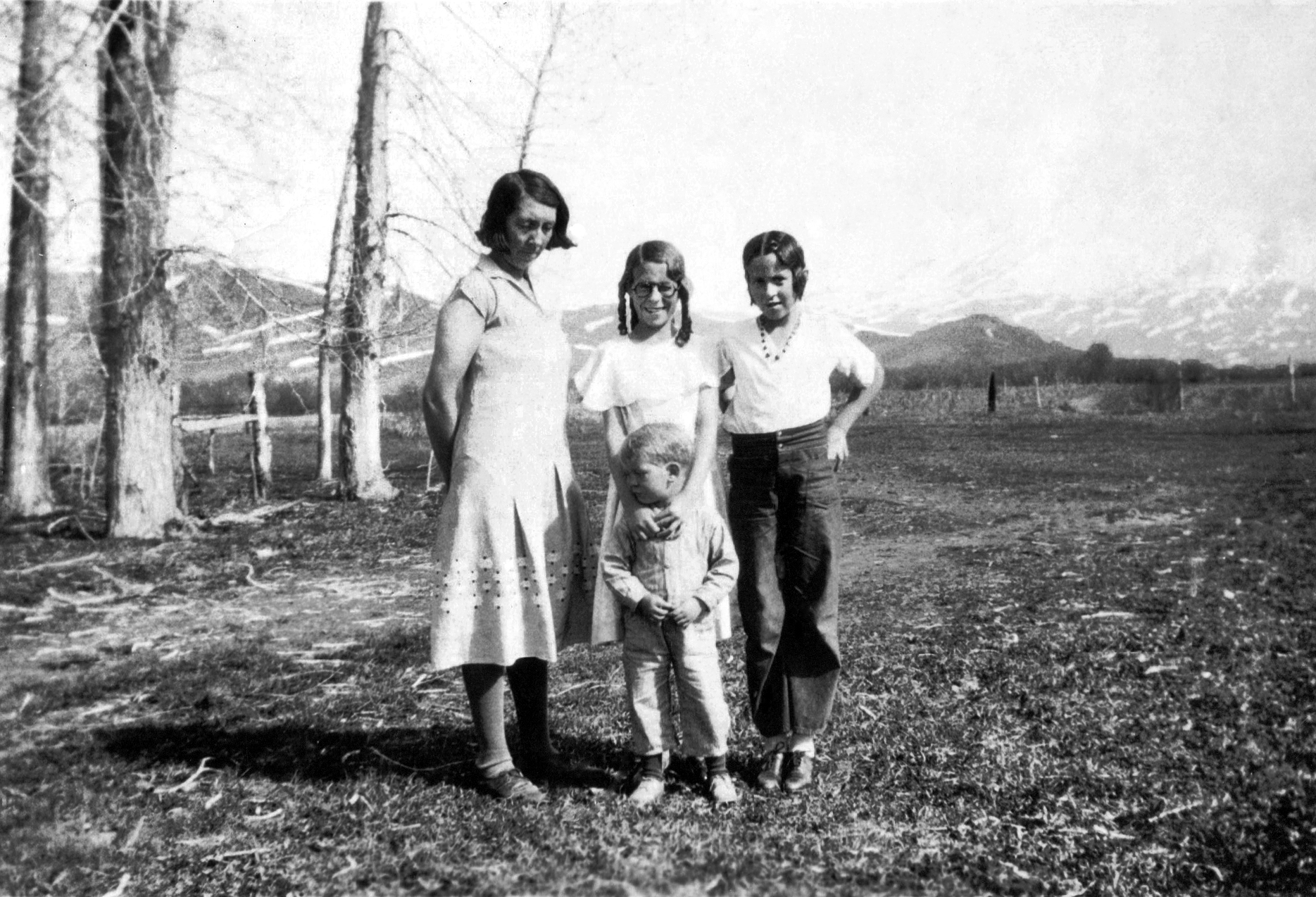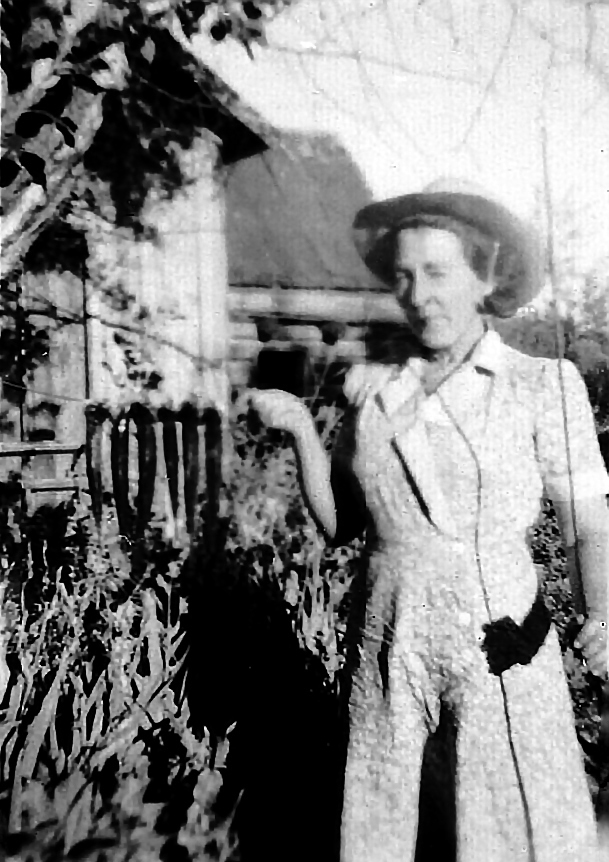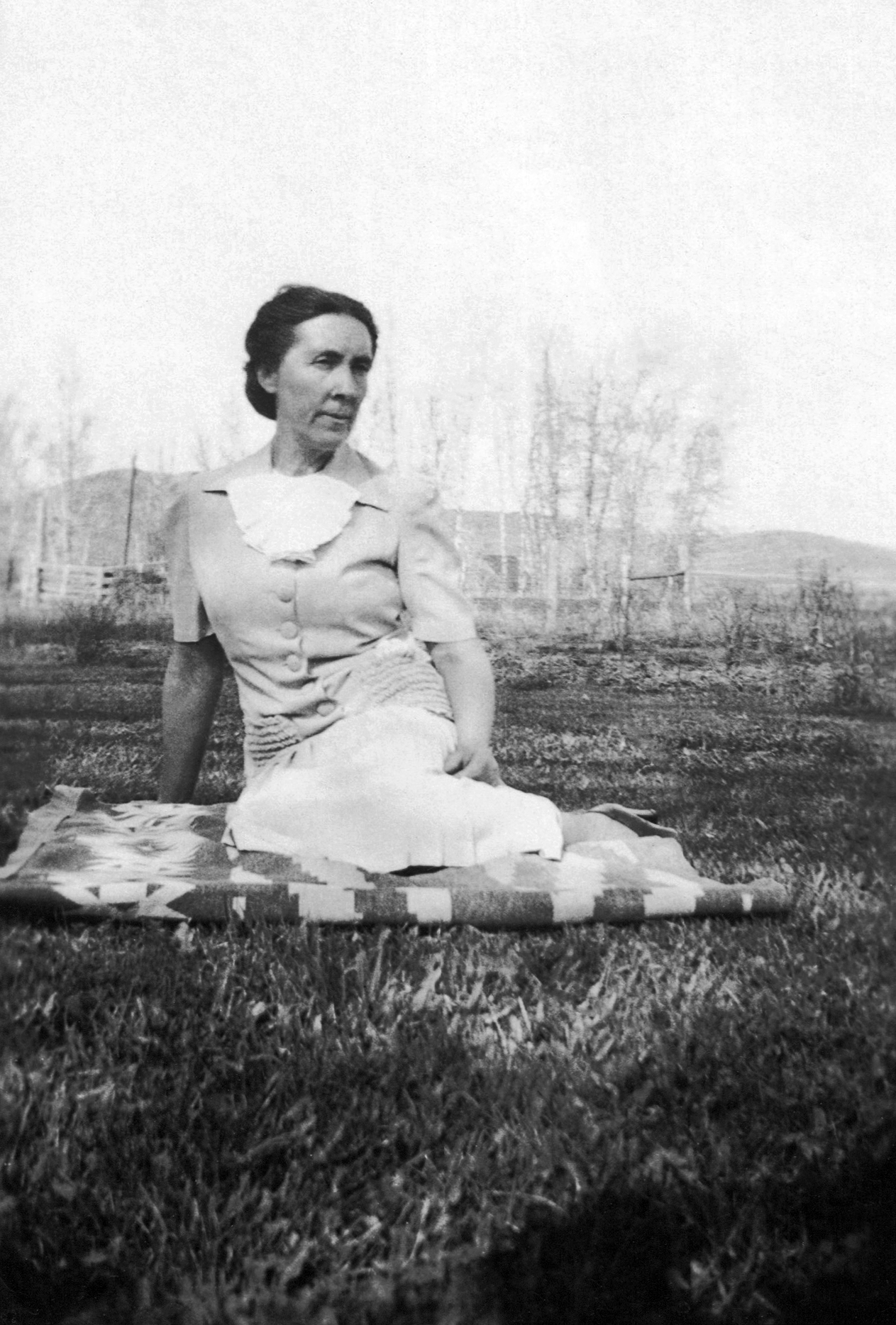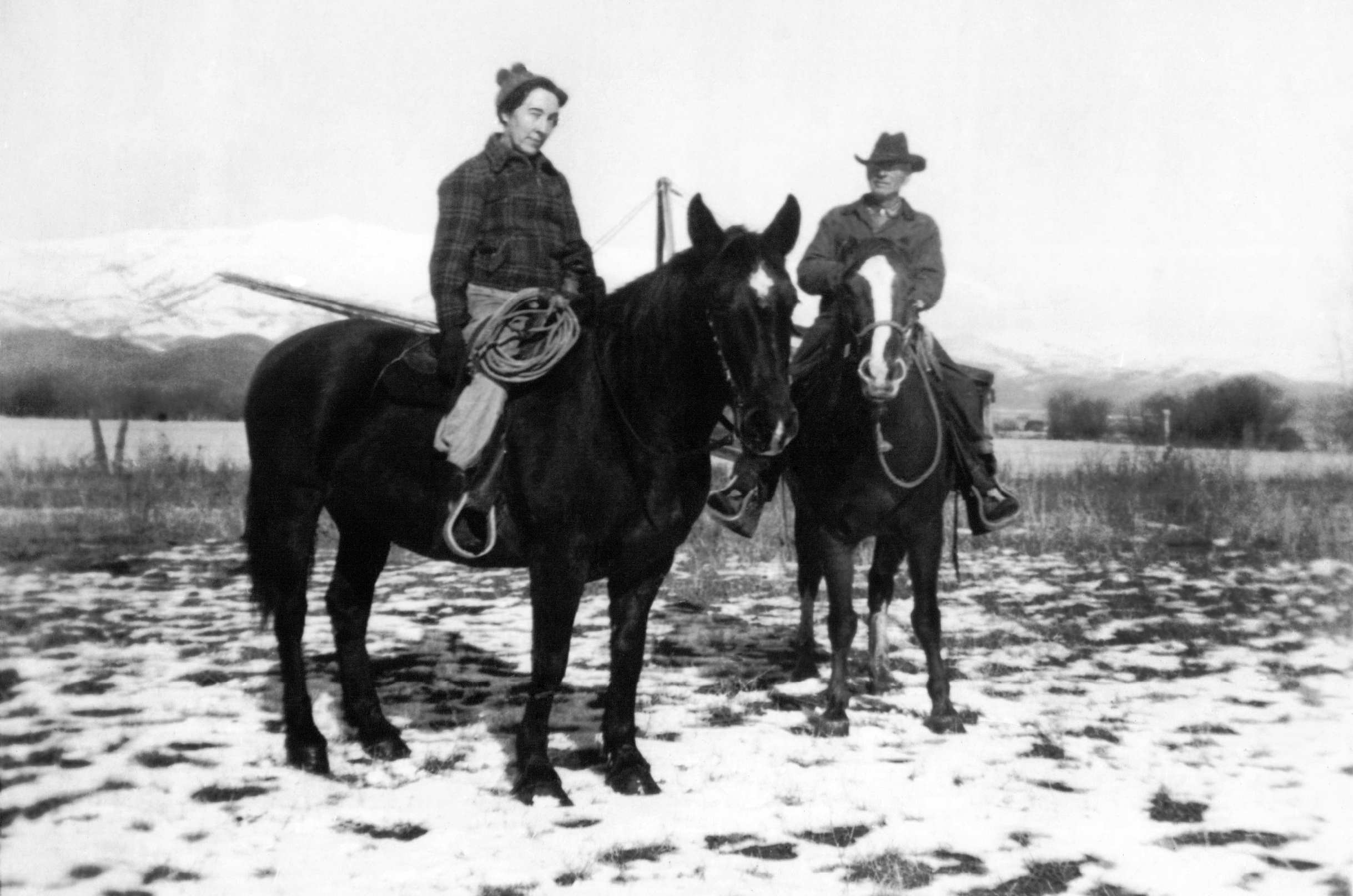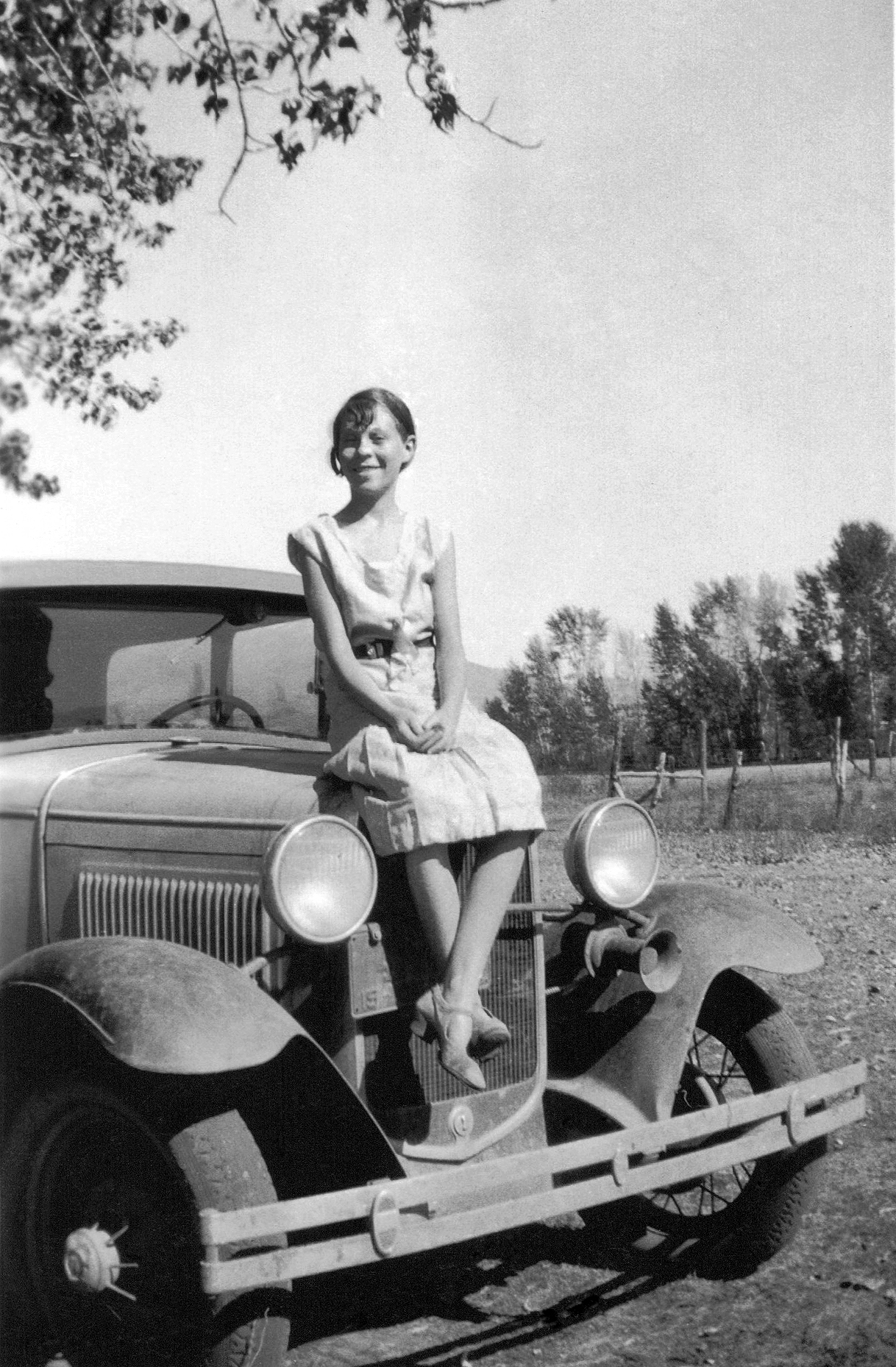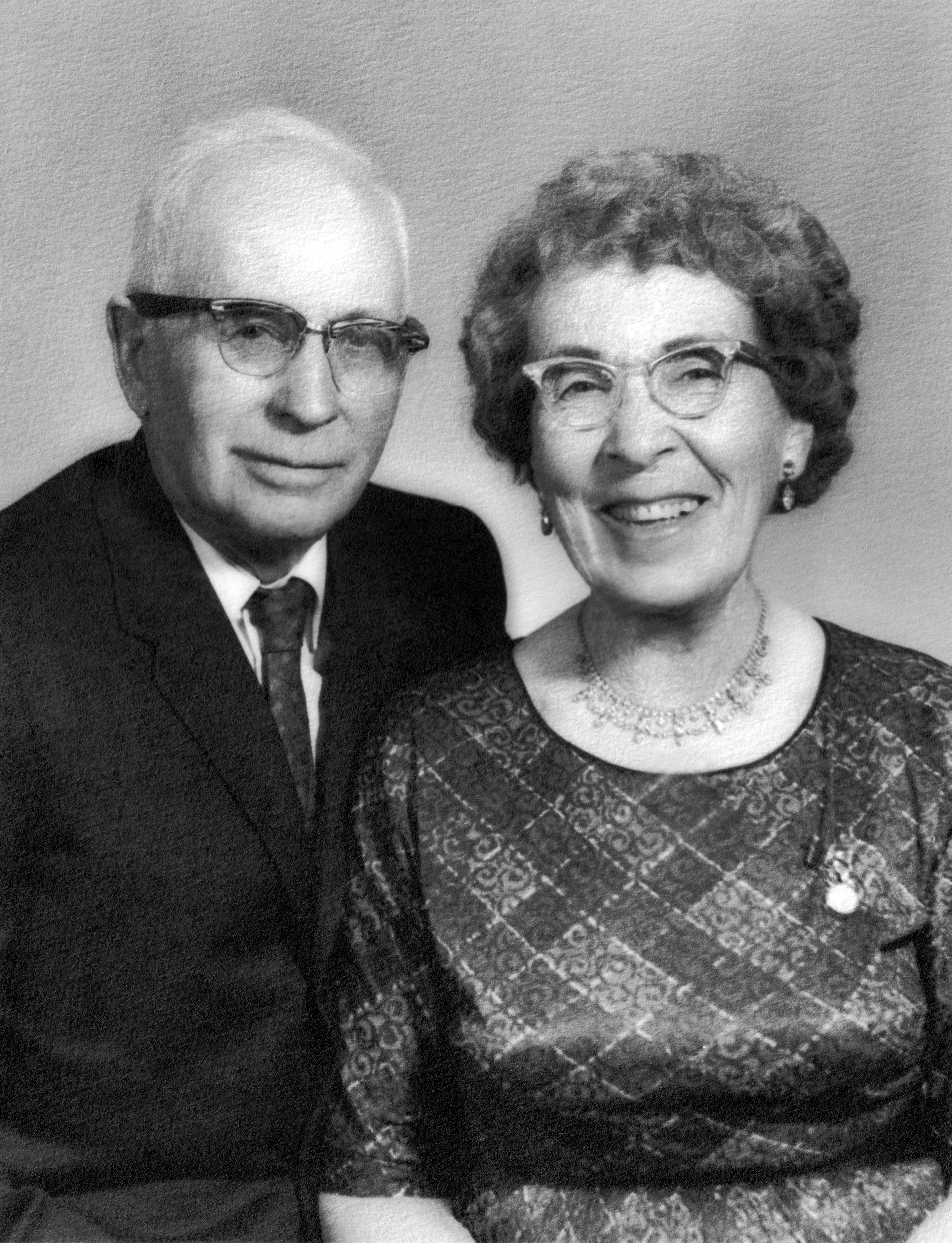Mattie Thorpe McCarter of Camas County, Idaho
by Joe McCarter
My daughter, Kate, asked me not long ago why, after so many of Dad's stories, I didn't attempt some of my mother's.
The difficult part is that Mother really never told stories. At least not in the way Dad did. There were probably several reasons, not the least being that she was usually too busy. She was never a very nostalgic person and much preferred looking ahead to better times than remembering the past.
Mother was also, in most ways, a strict traditionalist. I doubt she considered story-telling in front of more than one or two people, even family members, the proper wife's role.
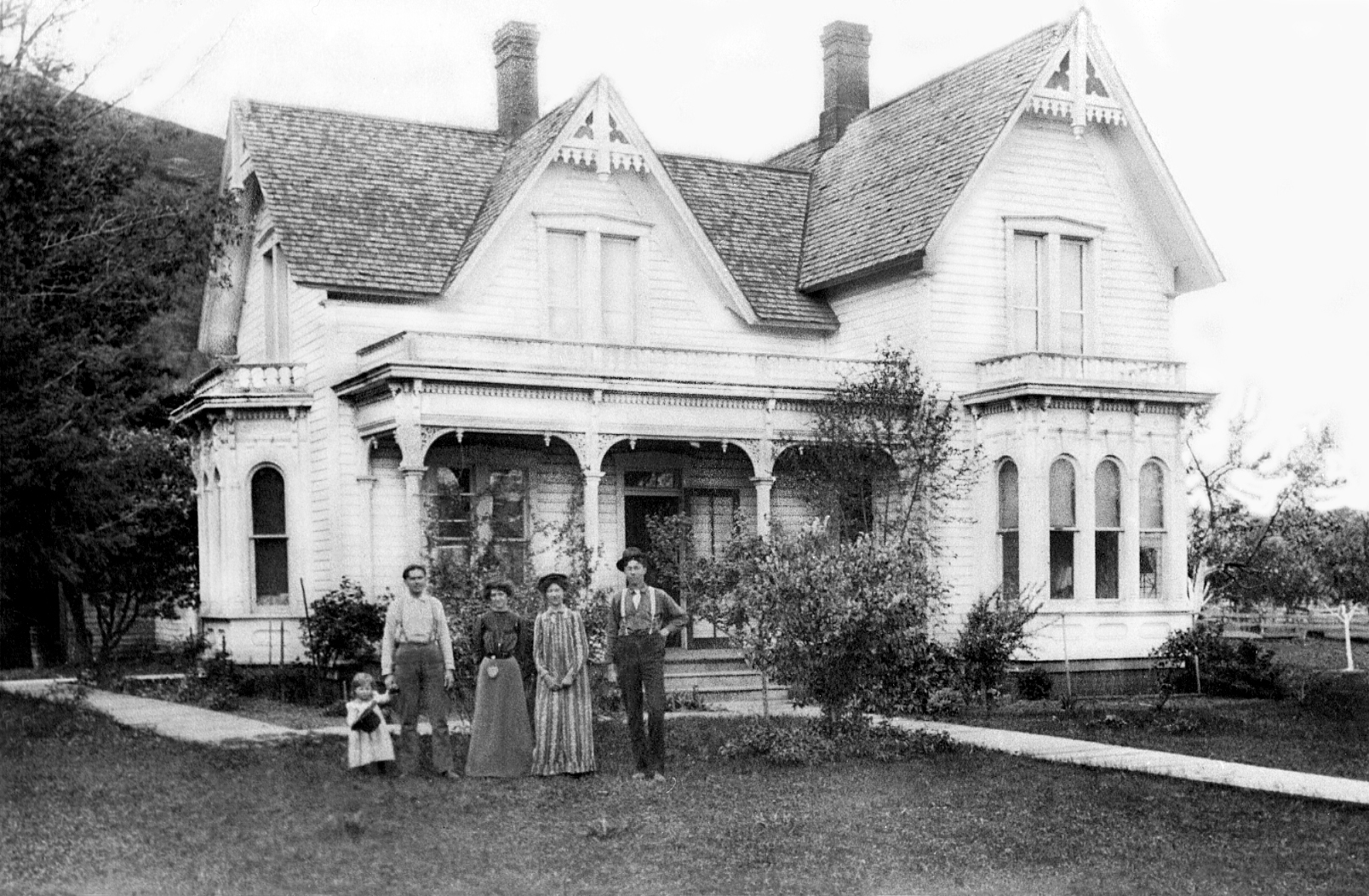 Mattie was born 6 Dec 1892 in this house belonging to her grandparents, Thomas and Martha May, in Dayton, Washington
Mattie was born 6 Dec 1892 in this house belonging to her grandparents, Thomas and Martha May, in Dayton, Washington
I can remember her telling me of her older brother Earl making her a playhouse which, in her memory at least, was very elegant. I also remember her describing learning to swim in the backwaters of the Columbia River near her childhood home in the state of Washington.
She also told about a dog her mother had who, when asked if he'd "Rather be dead or a Democrat?" would promptly lay down and play dead. Mother would end this story by saying her mother was a black Republican, adding that her father was a Democrat.
Her father had an orchard and kept a small general store in Marcus, Washington. She told of his once finding a morning glory plant in his orchard and immediately digging it out, creating a hole almost as deep as he was tall, before he was satisfied all the roots were removed.
I don't remember there being much humor in any of her stories, and they tended to be more to the point than drawn out.
So, instead of trying to re-tell them, and to offer tribute to her long and worthy life, I thought I'd do better attempting to describe her life as a ranch wife in what was so clearly a very different era.
It's difficult to imagine the expectations of young women of her generation. It must have taken a lot of courage to face the hard and often disagreeable work expected of rural women, not to mention the bearing and raising of so many children. Only the strong thrived, but of course, Mother was very strong.
While I'm sure she had access to a few more conveniences than her mother or grandmother, the industrial revolution didn't benefit rural women much until electricity was available. In her case it was in 1942, her fiftieth year.
Producing Butterfat
The thrifty, well run ranch in those days was a marvel of small intertwined enterprises which fed the family and hired help and provided a little regular cash income from butterfat and eggs while waiting for the annual proceeds from the sale of beef cattle.
Milk cows were probably the most important of these enterprises. They provided not only the milk, butter, and cottage cheese for the family, but the skim milk that provided the protein necessary for pigs, poultry, cats and dogs and their own buttermilk or bucket raised calves.
Although grandmother McCarter made and sold butter, Mother only sold cream. It was taken to Corral in five or even eight gallon cans and placed on the daily train to destinations as far away as Denver. The cans had a brass plate with her name and station etched in and were returned in due time.
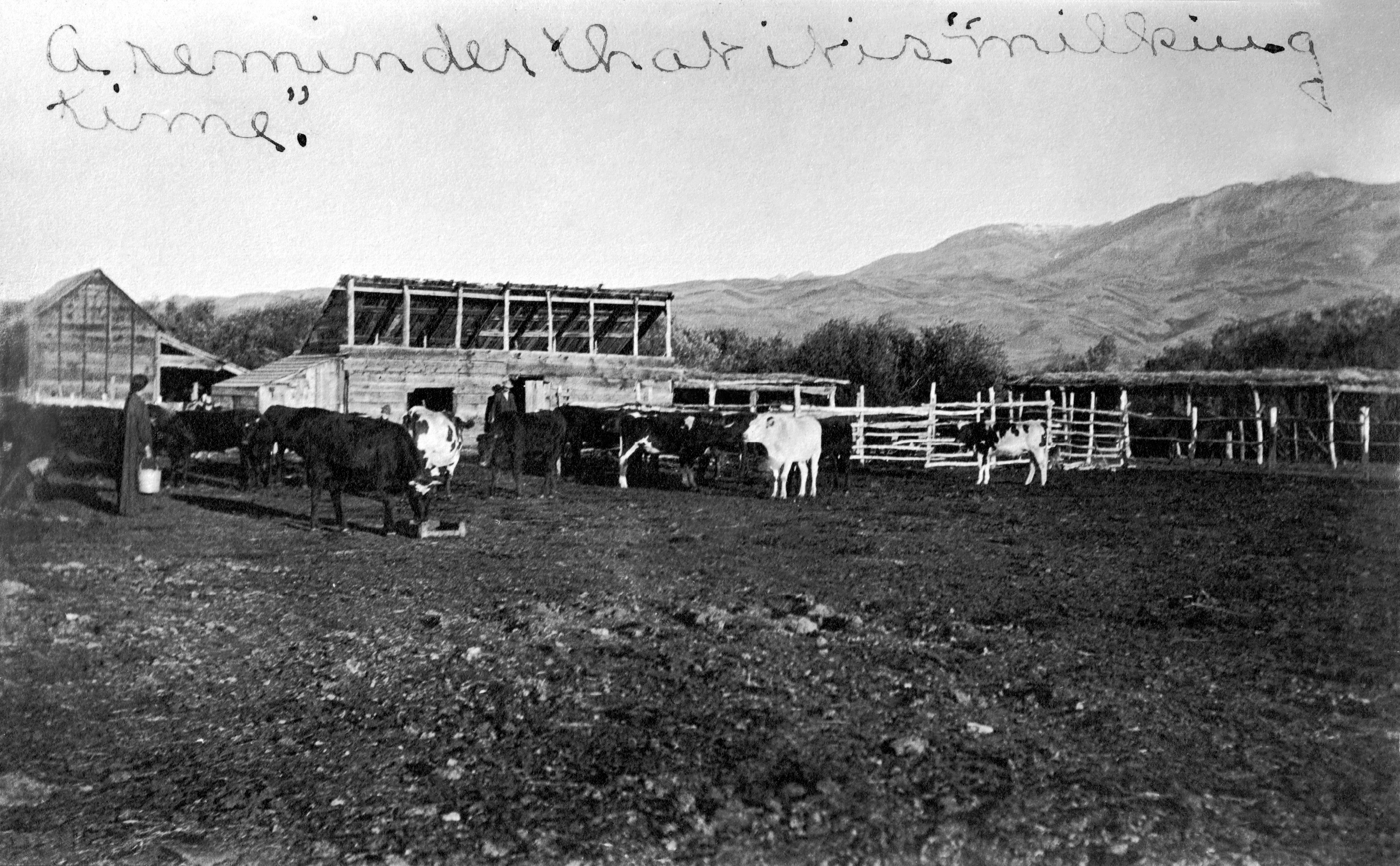
Mother was very good at doing all of the outside dairy chores. She could milk a cow quicker than most and also taught the baby calves to drink milk from a bucket.
The approved method meant straddling the calf with a half-full bucket of milk and placing fingers in the calf's mouth while submerging its nose in the milk. The idea being the calf would taste the milk and, being pretty hungry, start sucking on one's fingers thus swallowing the milk.
Each calf learned at at a different rate. After a taste, most would be inclined to butt the bucket as they would their mother's udder causing a milk explosion.
I can still see Mother with an in-charge look astride a squirming calf with milk streaming down her face. Getting thoroughly wet down with milk was always unpleasant, but on a cold winter morning it was really rough.
Some calves were almost impossible to train. After I was old enough, I did the easy ones since Dad simply didn't have the patience. Mother taught the hard, dumb ones. Oddly enough, I never saw the nipple buckets used today until I was nearly grown.
After the calves were trained to drink, it was a twice daily chore to feed them. They received whole milk for six weeks, then a mixture of skim and whole milk, and eventually just skim milk after they could eat some hay or grass.
The cream separator was in the old ranch house kitchen. Separators were ugly and smelly cast iron things with an attached hand crank that spun a bowl which separated the cream from the milk. Turning the crank required a good deal of strength and probably twenty or so winds to get the bowl up to speed. The cream, being lighter, was forced to the top where it ran out a spout into a container. The skim milk ran out another spout and back into the milk pail. Mother often turned the crank herself and then cleaned the many separator parts and milk pails on the back porch.
While Mother didn't make butter for sale, churning table butter was necessary once a week or so depending on how many people were being fed. The churns were like the separator only much smaller.
Churning was definitely a kid job and it usually seemed like the butter would never form. The cow's food varied depending on the time of the year and affected the butter making capability. In later years Mother had both an electric churn and separator.
Raising Poultry
The poultry were totally in the ranch wife's sphere. In Mother's case that was chickens and, in the early years, turkeys. Dad would sometimes clean the manure out of the henhouse, but Mother also did this using a wheelbarrow to haul it to the garden space for spreading in the fall.
On a daily basis, the chickens were fed and the eggs gathered. Egg gathering was more often a kid or grandkid job.
The eggs were cleaned and packed in an egg case which held something like twelve dozen. When the cases were full, they would be traded for groceries at the Fairfield grocery stores.
Egg gathering would have been fairly upfront and simple had there been no setting hens. These were hens whose maternal instincts told them they'd laid enough eggs for one season and that the time had arrived for brooding.
They would pick a nest out of the several available in the henhouse and settle in. Sometimes there were only one or two eggs in the nest or even just a wooden egg that was put to there to show the pullets where to lay. The setting hens would defend themselves and the nest against young egg-gatherers with a sharp beak and loud protestations. Getting the eggs out from under them was not for the faint-hearted.
The solution to the out-of-season setting hen, which required Mother, was locking her up in jail. Jail being a hog crate with a sliding door where the hen, usually along with two or three others, was confined for three or four days. Upon release the hen would usually give up her maternal instincts and go back to laying after a week or two.
One imperative driving the chicken raising process was making sure that enough hens were allowed to set early enough in the spring to assure fryers for haying. I can't remember Mother buying baby chicks until I was almost grown.
In early March, Mother, a true do-it-yourselfer, would select eight or ten broody hens with favorable traits. The selection criteria was known only to her, but I guess it generally included being of good size and demeanor, and not being flighty.
The hens were then moved to the scratch pen which was closed off from the other chickens, and placed in a wooden bushel fruit baskets. Mother first constructed a nest in each basket out of meadow hay and would place two or three eggs in it. This was to test the hen's reaction to the new nest and being moved and shifted about. Usually the lid to the basket, which could be fastened, was placed over the whole arrangement for the first night and day.
The process was conducted in the evening after dark. The next evening Mother would remove the lid and let the hen get off the nest to feed and drink. After eating, the hen usually got back into the basket on her own, but if she didn't, Mother would assist her once or twice. If the hen still had a problem returning to the nest, she (like in the game Monopoly) went directly to jail.
After two or three days of successful nest returning, the hen would be given more eggs to total around thirteen or fourteen. In three weeks the embryo chicks would peck holes in the egg shells and emerge. This was a particularly busy time for Mother, and she made many trips between the henhouse and her kitchen each day.
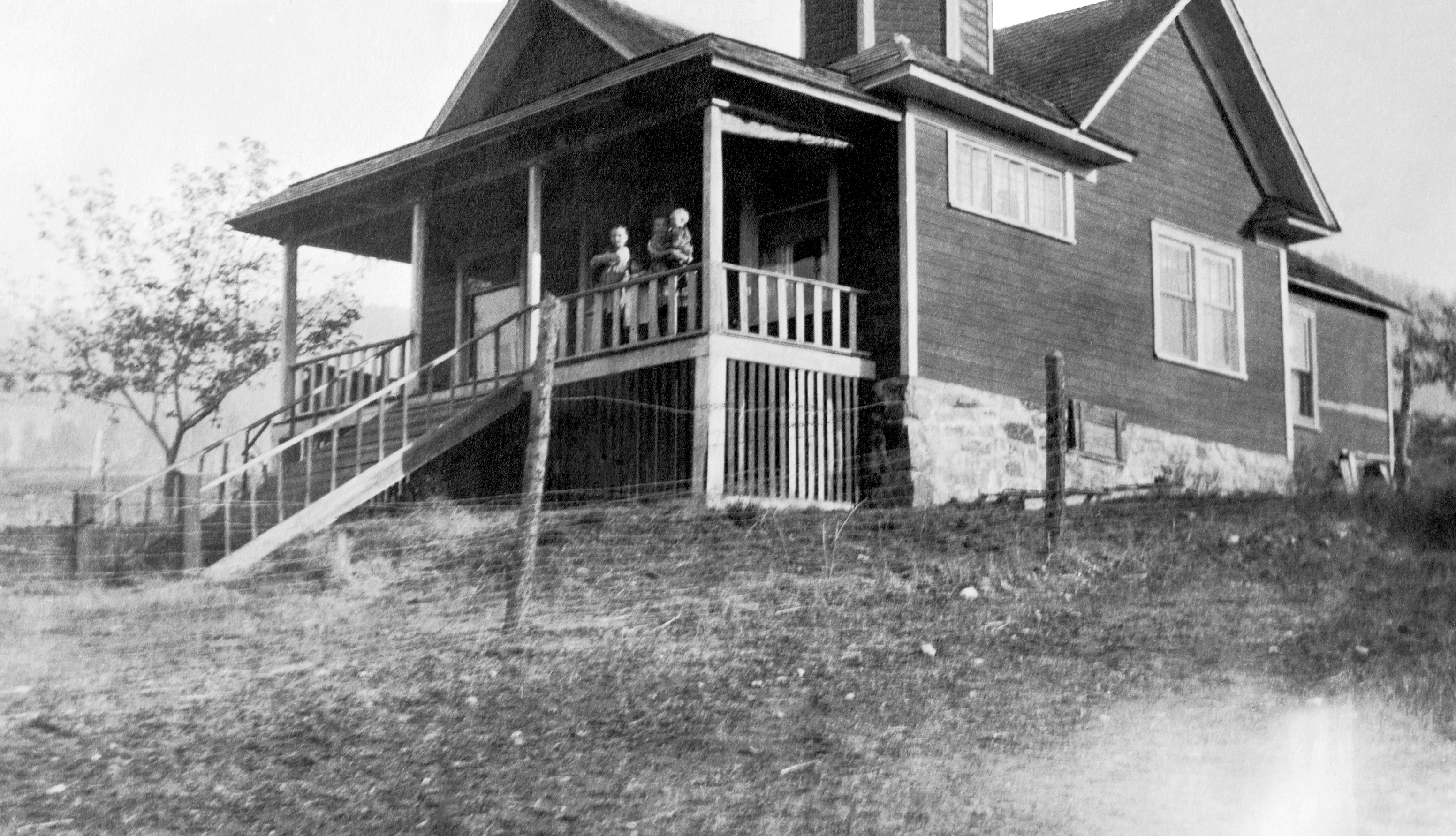
If the eggs were all hatching at pretty much the same time, she'd usually leave the hen alone. If not the chicks would be placed in a cloth lined box and moved to a spot beneath the kitchen stove.
Mother exercised a great many options with the baby chicks. If the mother hen was the only one hatching at the time, her chicks were usually returned to her. If several nests were hatching, the chicks would be distributed evenly among some of the hens. Not all eggs hatched and babies were sometimes killed in the nest. The more docile ones would then be given a fresh nest of eggs to brood.
Mother would make copious amounts of cottage cheese for the chicks and their mothers, and they also had chopped grain and hay leaves.
When the broods were out of the henhouse, crows and magpies would steal the chicks and Mother, who was an excellent shot, would use the .410 gauge shotgun to dispatch them. She also placed squirrel traps on the barnyard fence post to catch the offending birds.
Raising turkeys was different in that all the turkey hens would set after they had laid enough eggs. We didn't collect their eggs, and they usually made their own nests in the barn or other outbuildings. I don't remember her spending as much time with the nesting turkeys as she did the brood hens. Aside from being fed, the turkeys sort of raised themselves.
Shortly before Thanksgiving most of the young turkeys, both toms and hens, were butchered and sold as dressed turkeys. Mother quit the turkey business before I was old enough to help much with the butchering, although I can remember helping herd them in to a catch pen. Mother and Dad would both do the cleaning and picking. Butchering day was pretty grim as I remember.
On the other hand, the young fryers (roosters when large enough) were butchered on a day-to-day basis. Without any refrigeration, chicken was the only fresh meat we had in the summertime. None of the pullets (young hens) were killed. They would begin to lay along later in the fall and would supply the next season's eggs and fryers. Mother usually kept two or three of the young roosters, and she would often trade them with other ranch wives to keep the flock from becoming too inbred. The older hens and roosters would either be butchered or sold.
Buying Winter Supplies
Dad had bought a 1938 Chevrolet pickup about the time WWII started and having the pickup enabled Mother to take the old hens to Gooding where a poultry railroad car came in on a regular basis each fall. The year I was 13, Mother and I made this annual trek to Gooding.
Help was scarce because of the war, and Dad was very busy, so he secured a driving permit for me to drive grain to the elevator. Mother didn't drive as far as Gooding, so that year I did the chauffeuring.
After selling the old hens, we went to the local Safeway store and laid in the winter supplies. This was a dozen sacks of flower, two sacks of sugar, and six or eight sacks of potatoes as well as beans, canned goods, and many other things. Mother was always proud that the chicken money paid for better than half of the grocery bill.
After some other shopping, we started home as it was starting to get dark. This was what made the trip noteworthy. I had turned on the old Chevy's lights and everything appeared to be fine, but when the first corner came up the lights went out.
Now Mother was a person with boundless capabilities and strengths, but none of these included anything at all to do with automobiles. She was, by her own admission, a terrible driver and very little better as a passenger.
Up to that point, things had gone fairly well because I hadn't exceeded the wartime speed limit of 35 miles per hour (which she enjoyed), and she really restrained herself pretty well there in the darkness.
I was able to stop smoothly and luckily found two or three fuses in the jockey box. After considerable groping around underneath the dashboard, I got the old fuse out and replaced. The lights came back on, but only until the next corner.
We went through this cycle about three times before I discovered that applying the brakes was causing the fuses to blow. Since we had installed the last good fuse, we resolved not to use the brakes any more. This worked out well, although very slowly, until we were nearly home. When we passed Willy Hobdey's place, some hogs were out and one ran across the road. I couldn't help but hit the brakes and, of course, we were again in the dark. Luckily, by this time, the moon was out and we made it home by moonlight.
The trip would have been judged a success had not the long slow drive home allowed all the potatoes to freeze slightly. We ate a lot of rather sweet tasting potatoes that winter.
Raising Pigs
Another small industry on the ranch was raising pigs. Pork was a big part of the diet because it lent itself so well to curing, that is salting and smoking, allowing it to be kept unrefrigerated until the next butchering season. Pigs required animal protein to survive, so provided a use for excess skim milk which was the by-product of butterfat production. They were, as well, efficient kitchen waste disposals. Pigs also needed ground grain to reach maturity, so we gave them barley which was produced and processed on the ranch.
Dad kept sows and raised pigs until I was almost grown. After that he bought weaner pigs for our own use. In November we usually butchered five or six 200+ pound hogs. We then scalded them over at the Hot Springs to help remove the hair and then brought them home to cut into hams, bacon, shoulders, and fresh meat that would be ground into sausage. We always had a smokehouse, a small enclosed shed, in which Mother would stack the meat in tiers after it was covered with brown sugar and salt.
She also processed the rest of the meat for sausage and lard by cutting it into pieces that would fit into the hand crank grinder. We all took turns at the grinder because it required about all of one's strength to turn. Mother took her turns at the crank as well as seasoning the sausage with judicious pinches of sage and salt.
After the grinding she rendered the lard by cooking it on the stove until it was melted and then poured it into containers. This was a delicate procedure because the lard would burn like kerosene if exposed to flame or even if, as she always maintained, overheated. Fire was an ever present danger on the ranch.
Later in the winter, usually late February or early March, Mother would begin sampling the ham and bacon by cooking and tasting small pieces to see how much salt and sugar had been absorbed. When it was about right, she would clean off the excess and hang the meant inside the smokehouse and start the smoking. This consisted of building a very small fire and placing green wood, usually alder or sometimes apple tree trimmings, on the fire to make a smudge. The smoking process went on for about ten days or until the meat's color was correct. The cured meat was then hung in the coolest place available.
Mother's contribution to the pork enterprise didn't just consist of processing the meat. She also gave them their daily skim milk. For some reason it was better to let the milk cool before giving it to the hogs. So before she started the morning milking, she had to empty the skim milk from the evening's milking pails. Emptying the kitchen slop pail was kid work, if they were available, otherwise Mother did it.
The whole family was always very interested in the young animals after they were born. Once when Mother and some of us kids were watching a new pig litter just starting to explore, a little one fell off the shed floor. It was only an eight or ten inch drop, but too much for the little one to get back up. The sow was around the corner of the shed eating. Mother, after no little discussion with the group, decided it would be safe to climb over the fence and put the piglet back with its litter mates. This was not a hasty decision, by any means, as sows with little ones were noted for being unpleasant.
Anyway, Mother reached the piglet with no trouble, but it squealed a little bit as she picked it up. The sow, of course, heard her babe. Now hogs have an extensive vocabulary of grunts and sounds, and the one they use when they're angry or on the attack is the scariest of any farm animal. In the blink of an eye, the sow had rounded the building at full speed and in full cry. Mother sort of tossed the piglet onto the floor and, although it was only four or five paces to the fence, she reached it in full stride. I doubt any Olympic hurdler could have cleared that four foot fence with much more ease or spare room than Mother did.
Gardening
The other major home enterprise was gardening which was as much a necessity as the milk cows or chickens. I doubt that any store in Fairfield stocked fresh vegetables in the thirties, and a trip to the store more often than every two weeks would have been considered superfluous anyway.
Camas Prairie's 5,000 foot elevation didn't offer the best gardening opportunities, but this didn't seem to daunt Mother. She much preferred gardening, whether flowers or vegetables, to other work. She would start planning long before the snow had left. The seed catalogs that came through the mail were a great source of comfort and solace for her through the long winter.
Her favorite catalog came from North Dakota and specialized in cold country garden varieties. She even tried a variety of watermelons one year. One or two, about the size of footballs, almost ripenned. While they didn't taste real great, it gave Mother a lot of satisfaction.
Haying
From the day the snow went off until it flew again there was very little slack time for Mother. But around the first of July haying would begin and that had to be the busiest time for her and, for that matter, the rest of the family. It usually meant four or five extra hands to cook for as well as adding to other chores.
She would be up before it was really light outside and spend an hour or so weeding in the garden. She particularly enjoyed this time of day and the coolness made the hoeing easier. She'd then build a fire in the cook stove and get everyone out of bed. She'd help with the milking and feeding the calves, and then run in and cook breakfast, first making sure she had a few young roosters locked in part of the henhouse.
Ranch wives prided themselves in setting a good table and, while there wasn't anything fancy, the food always tasted great and was designed to fuel the heavy physical labor.
The challenge presented by having no refrigerator or ice box was formidable. The butter and some other perishables had to be kept in a bucket lowered into an old well. Once food was prepared it had to be eaten although the pigs, dogs, and cats saw that nothing was wasted. She always said if she had to give up the appliances electricity had brought her, the refrigerator would be the last to go.
Breakfast usually began with oatmeal. Then there would be eggs, ham or bacon, and biscuits and gravy or pancakes. It was always fun to watch her make the biscuits. It didn't take her more than ten minutes before the pan was in the oven. She always had enough dough left over for two biscuits that she would bake on a coffee can lid. These were really special because they were crusty on all sides.
After breakfast she would make another pan of gravy and mix in left over biscuits or pancakes for the dogs and cats since there was no commercial cat or dog food in those days.
Mother was fortunate that there were almost always daughters or granddaughters to help with meal preparation and housekeeping, as well as outside chores, but she was always the driving force.
She would have heated enough water cooking breakfast to scald and pluck a couple of roosters not long after the meal was over. She, of course, first had to relieve the hapless chickens of their heads using the ax and chopping block at the woodpile.
The noon meal, or dinner, would be fried chicken and mashed potatoes, gravy, and usually some kind of beans, and sometimes beet greens or Swiss chard. Later in the season there'd be corn on the cob with plenty of homemade bread and butter. Two fresh pies were the traditional noon time dessert.
Supper really wasn't that much different than dinner although cured pork was more common than chicken. Cake or strawberry shortcake was the usual evening dessert.
Then there were evening chores to do.
Washing
Monday was wash day and, in the summertime, usually started with Dad making a trip in the go-devil or stone-boat over to the Hot Springs for water. The go-devil was a homemade platform with small logs for runners that was convenient because it was low to the ground. It had a box to haul things in and held a 50 gallon oil drum for the hot water.
The well in the old ranch house was a shallow sandpoint driven into the ground and its water contained a lot of iron pyrites giving it an unpleasant taste and a really poor nature for washing clothes as it stained white things yellow.
The Hot Springs water was softer and also much better for washing because it did not require the stove going full blast all day heating water in large boilers.
One of the few somewhat modern conveniences Mother had was a gas-powered washing machine. It's brand name was Conklin which was written in script on the side of the tub. It was powered by a Briggs & Stratton engine which started with a kick pedal. Starting it wasn't too hard in warm weather, at least.
The washer was kept in the woodshed just off the back door. There was a flexible metal tube that could connect to the engine's exhaust enabling the washer to run inside. I don't remember her ever using the washer inside probably because it was so noisy, and I doubt that she trusted that metal tube.
Usually in the wintertime she washed things out by hand rather than face the cold of the open woodshed.
Sewing
Mother really loved to sew. She had an old Minnesota foot treadle machine that she could really make hum. She had two aunts in California who were fairly well off, and they would send her their cast-offs which she cut down and remade into very nice, stylish dresses for the girls. Like most everything else she did, sewing was easy for her, and she could put dresses together with amazing speed.
One of the nicest stories about Mother concerned her sewing ability and a neighbor girl, Mildred Jones. There were a lot of siblings in the Jones family and, while the family was not that hard-up, the father, Harvey, was extremely close with the dollar. Mrs. Jones did not sew and the two girls in the family had little to wear and nothing very nice. However, Mildred, who was about through with her grade school years, had somehow wrangled ordering a new dress from one of the mail order catalogs.
The occasion was the Christmas pageant at the Corral Creek school. These pageants were the highlight of the Christmas season and were attended by the entire community. All students had to learn a poem or song to present, and there was usually a play or two and group carols sung. Afterwards presents were exchanged and it was just about, with the exception of the last day of school, of the greatest day of the entire school year.
With the program nearing, the mail order package had, as yet, not arrived. Finally, the evening before the awaited day, Mildred rode horseback down to the Corral post office for one last check. This was a good two hours round trip and the weather was bitter cold.
In the winter it was customary to get the neighbor's mail whenever making a trip to the post office. Mildred had picked up our mail and stopped at the house to deliver it. Her package had not arrived, and she had cried so hard most of the way home that she had thrown up. Mother made her some hot chocolate and tried to calm her a little.
After she left for home, Mother could think of little else but the devastated girl. She took stock of dress material she had on hand and found it pretty scarce, but she came up with a jumper. This required a blouse, and she had nothing for it except a piece of lovely new yellow satin that she had held back for some important occasion. She knew her own daughters had long admired the material, but they had their Christmas dresses ready, so she set to work.
It took her most of the night to sew the outfit working by the light of the kerosene lamp, but Mildred wore her new dress to the Christmas pageant.
Decades later, when visiting Mother in the nursing home, Mildred recounted this incident saying it was the nicest thing anyone had ever done for her.
Mail Order Mishap
Dealing with the mail order companies was a constant preoccupation for Mother. Catalogs were as necessary as a team of horses or a milk cow to most rural folks of that era. In fairness to the catalog companies, most of the orders were handled as well and as speedily as most things happened then.
There were sometimes substitution, back ordered, and temporarily out of stock phrases stamped on the original returned order blank. Usually the substitutions were adequate because the policy was that a similar item of higher price or quality would be shipped instead of what was originally ordered.
Most companies offered a personal service department for correspondence and Mother, who could phrase and write well in her distinctive backhand style, was not shy about using this. If the occasion demanded, she could be pretty tough with them. This was giving them what for in her terminology. One of her longer and more acrimonious series of correspondence occurred with Sears Roebuck after I was grown. Dad and I had a lot of fun kidding her about it, and I think it's worth re-telling.
The first electric stove she had was a Sears model and was a pretty satisfactory appliance and pleased Mother most of the time. However, it had come equipped with what was called a deep well cooker instead of the left rear burner. This was, more or less, a built in removable pot recessed into the stove top about eight or ten inches. Mother never used the pot and felt a regular burner would be much more useful.
Reading some of the accompanying literature, Mother found that there was a conversion kit available to replace the deep well. So carefully including all the necessary serial and parts numbers, she ordered it.
I helped her install the new burner after it arrived, and it turned out well except for one thing that really nagged her. In the center of the other burners there was a small round filler piece. This was missing on the new burner allowing one to see into the stove innards which was decidedly lacking in aesthetic properties. We searched and searched through the conversion kit boxes and this piece had clearly not been included.
Such an omission didn't daunt an old catalog hand like Mother, and she immediately whipped off a letter to Sears outlining the problem. Since the piece in question lacked a part number, always a matter of high importance in dealing with any of the mail order services, she included a detailed sketch of the burner and its missing piece complete with arrows, descriptions, and footnotes.
In due time Sears responded with an apology and said that the part would be shipped from the factory. This wasn't an unusual message and, in real terms, meant that sometime during the course of the next three or four months one could possibly expect a package.
In a month or two, sure enough, leaning against the mailbox post was a 4 feet by 10 inch wooden crate from Sears. She had walked the quarter mile to the mailbox and, being Mother, shouldered the thing which weighed something like 25 lbs and returned to the house wondering why anything the size of a 50 cent piece would require such elaborate packaging.
Dinner time was at hand and opening the crate obviously required tools she did not have handy. So after dinner I was enlisted and, with great expectations, we disassembled the magnificent crate. There was enough excelsior for several packages and deeply embedded in this was a piece of sheet metal about 8 inches wide and as long as the crate. Clearly there had been a terrible mistake and, in fact, there was just no similar piece to be found in any location on the stove, let alone one of the burners
I don't remember Mother ever being as put out with Sears as she was at this time. Dad was enjoying all of this immensely and his opining that it was "probably the picture she'd drawn that threw them off" didn't make her feel any better.
It was a few days before Mother rallied, but she did. Wrapping the offending sheet metal and binding it with twine, she returned it. She'd be darned if she was going to pay another $3.50 for return postage. She included a really blistering letter describing her trip from the mailbox, her bitter disappointment, and again included the litany of serial, model, and kit part numbers and general descriptions as well as the entire history of the affair.
Sears followed up with a very nice apologetic letter with excuses of all kinds and said they would immediately respond with the correct part, again from the factory.
Two or three months later, when Dad and I were coming down from the Lundy place for dinner, there leaning against the mailbox post, was another wooden crate identical to the previous one. At least Dad and I were driving the pickup, so we didn't have to carry it in.
We approached Mother with some caution since the situation had really gotten past the amusing stage by now. I asked her if I should unpack it, and she refused saying that she was just going to ignore the thing. She and Sears both steadfastly did this until they threatened her about not paying for the shipment. Then she really gave them what for. Their reply was that they would consult their attorney if she refused to remit the six or seven dollars outstanding. Her reply was that she would consult her attorney and that officially ended the saga of the unidentifiable stove part.
That crate leaned against the old woodshed wall long after the folks had retired and moved to Hagerman.

Driving
I previously mentioned Mother's general difficulties with automobiles. This was probably not unusual for her horse-propelled generation, but cars could easily reduce her to a basket case. Unfortunately, Dad wasn't a lot better, although he did get by.
Dad bought their first car, a used Ford Model T, not long after they returned to the ranch from Montana. This was considerably before my time, but my sisters tell and re-tell the stories to this day.
They were spending summers over at the homestead house which was a mile or so from the old ranch house and getting moved twice a year necessitated many trips between the two houses, so the car was most convenient. Unwillingly, but with grim determination, Mother learned to drive, sort of. Normally as quick-witted as anyone, she tended to freeze at the controls when events turned unexpected.
One of the first mishaps occurred at the homestead as we called it. Dad had built a brand new toilet with a fresh hole and the works, of which the family was dutifully proud and impressed. Not long after its completion, Mother gathered most of the family into the "T" for a trip to Corral after having prepped and cranked it with a minimum of problems.
The first move from the car's usual parking place required backing up and turning to gain space for a corresponding forward turn. Something, whether the engine was running unexpectedly rough or a daughter was out of place, distracted her enough that she turned a little less sharply than usual and was reversing straight for the new toilet.
Unfortunately, when seeing where her general direction was taking her, she panicked and froze. Slowly the "T", with Mother's foot stuck on the reverse pedal, met the toilet which it moved enough for a hind wheel to drop into the new hole and, mercifully, halt all backward progress. Dad was said to be understanding and able to salvage the new toilet with few problems. It was some time before Mother felt confident enough to try driving again.
Another time, again with family loaded and Corral the destination, Mother froze in forward motion. Going from the homestead to Corral required opening a couple of wire gates and, while she had negotiated the same route and routine several times, for reasons unknown she froze going forward, albeit at no great speed. The difference this time being that she was able to pull back on the steering wheel and shout whoa. Nothing but the gate sustained serious damage, however.
While cars improved greatly during her lifespan, unfortunately her driving skills didn't respond accordingly, and she seldom drove even to Corral. Mother never believed in running around anyway. Her home, garden, and livestock, and her family, were enough for her.
Conclusion
Readers should not get the idea that the tasks I've mentioned were anyway near all that Mother performed. The days, particularly in the spring and summer, were simply not long enough for her. There were always things waiting. She would compare her abilities, unfavorably at times, with her mother-in-law's who was evidently a paragon of ranch wives. To use one of Mother's expressions, I always took these comparisons with a grain of salt because Mother could outwork anyone I ever saw, woman or man.
She also managed to keep herself well informed about events, be they local or national. Although we were not on a mail route until after the war, and then only three days a week which caused the daily newspapers to arrive in bunches, she would read everything thoroughly. She also read The Idaho Farmer, The Farm Journal, The Saturday Evening Post, The Lady's Home Journal, McCalls, and Newsweek. She often had a book going too, especially in winter time.
Cash money was a scarce item a great deal of the time during all her childrearing years, but certainly none of us ever lacked any necessity. There were rural people during these hard times who did severely lack things, even food. Mother usually characterized them as shiftless although she was a charitable as anyone.
The simple truth was that it took hours and hours of hard and often unpleasant work by both parents to keep food on the table. The ranch families then may well have been better off in general than many today. If industrious, they could at least eat well and survive despite the lack of cash.
Mother and Dad and their generation are now gone. They were the last of the rural folks who represented Thomas Jefferson's vision of an enlightened yeomanry living the independent, self-supported, pastoral life.
The soil produced the crops that sustained the animals while they, in turn, lent their waste to the soil to help make it fertile again. Ranch folk could eat and wear and, with careful husbandry, prosper on the excess. Along the way, they raised the sons and daughters who built America.
The symmetry was as real and honest, and as beautiful, as the many generations of rural Americans who lived and produced it.

